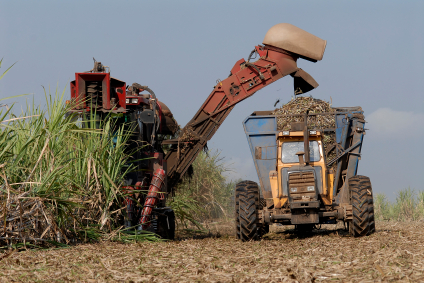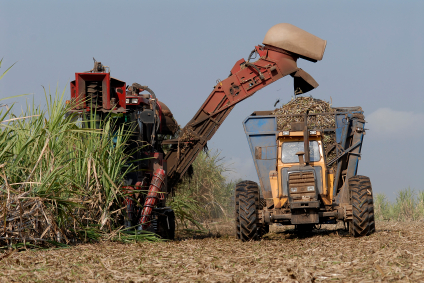 Not as sweet as advertised: industrial-scale sugarcane production in Brazil.This is a post about Brazil’s sugarcane-ethanol “miracle,” but I can’t resist starting off with a look askance at our own corn-derived ethanol phenomenon. Has there ever been a “green” technology more ecologically discredited than corn-based ethanol?
Not as sweet as advertised: industrial-scale sugarcane production in Brazil.This is a post about Brazil’s sugarcane-ethanol “miracle,” but I can’t resist starting off with a look askance at our own corn-derived ethanol phenomenon. Has there ever been a “green” technology more ecologically discredited than corn-based ethanol?
It may yield slightly more energy than it consumes during production–but only if you grant a generous credit to distillers grains, an ethanol byproduct now busily being shoveled into CAFOs (and exported to China) as a highly dubious livestock feed. But corn ethanol’s unimpressive energy balance makes it a pathetic candidate to displace energy-rich petroleum gasoline.
Moreover, its total greenhouse gas emissions are likely titanic–a fact limply acknowledged by the EPA and then eventually retracted under industry pressure. For the love of God, the stuff is based on industrial corn–by far our biggest user of soil-degrading synthetic nitrogen fertilizer.
Yet the corn-ethanol behemoth lurches tediously along, forever demanding, and too often commanding, ever-spiralling amounts of government support and arable land. Sigh.
Too bad we’re not more like Brazil, where they’re displacing petroleum with highly efficient sugarcane-based ethanol … right? Well, no. In 2006, I co-wrote an article about what Brazil’s much-heralded cane ethanol revolution has to teach the United States. The conclusion: not much.
Now comes this blistering report from Foreign Policy magazine exposing the myth that sugarcane ethanol is some sort of environmental panacea.
Before I get to the details, I want to make the point that the biofuel-as-panacea impulse is only possible in society’s whose citizens fundamentally don’t understand agriculture. Biofuels are hailed as “renewable,” because crops can be grown on the same land year after year. But monocrops destroy soil–properly thought of as a non-renewable resource–and require lots of agrichemical poisons. Therefore, industrial-scale biofuels aren’t renewable. (Whether biofuels can work sustainably in regional niches, as part of a diverse cropping system, is a different question).
Okay, where was I? In the FP piece, author Nikolas Kozloff jumps right to the point in his lead:
While sugar cane ethanol is certainly less ecologically destructive than some other biofuels, the industry’s boosters have overlooked one key fact: You’ve got to plant sugar cane somewhere. One couldn’t pick a worse place to harvest cane than Brazil’s Atlantic rainforest. There, sugar cane crops have led to deforestation and, paradoxically, more carbon emissions.
He goes on to explain that the flattening of the Atlantic rainforest–distinct from the Amazonian one–stands as the original sin of Portugal’s colonization of Brazil. The history of several tropical crops we now take for granted–for example sugarcane and coffee–is essentially the history of razing of that vast forest (twice the size of Texas, with as much biodiversity as the Amazon forest). And this ecological crime was compounded by the use of slave labor, Kozloff reminds us. “The colonists shipped six million African slaves to Brazil to do the cutting,” he writes: surely one of the vilest episodes in human history.
Today, just 7 percent of the original Atlantic rainforest remains–and sugar producers are busily tearing into that precious remnant as ethanol production kicks up. In the last year alone, Kozloff writes, the government has had to fine two dozen companies for illegally clearing some 143,000 acres of Atlantic rainforest to plane sugarcane.
The explosion in cane-based ethanol has potentially dire implications for the Amazon rainforest, too. I shouldn’t have to note that the Amazon is one of the globe’s great climate-stabilizing assets. It’s also home to groups who have been living there for generations–making use of its resources without destroying them. Any “green” fuel that triggers Amazon deforestation and displaces people is an abomination. Even though sugarcane doesn’t do very well in wet conditions, “hundreds of thousands of acres of sugar cane have been planted in the Amazon,” Kozloff reports. Then there are also indirect effects–cane displaces other crops and pushes them into the Amazon region. Kozloff writes:
In the state of São Paulo, sugar cane has been planted on former pastureland and this has pushed cattle into Mato Grosso. Hundreds of thousands of cattle are moving into the Amazon every year as a result of displacement by ethanol in the state of São Paulo alone, say environmentalists. This migration is becoming all the more likely since one can purchase 800 hectares of land in the Amazon for the price of just one hectare in São Paulo. Additionally, some soy plantations in the center of the country have been turned over to ethanol production, prompting concern among environmentalists that this will lead soy producers to move into the Amazon. And local observers say that sugar cane plantations are already pushing soy farmers and ranchers into the rainforest.
Then there’s the problem of nitrogen fertilizer. As in, sugar requires plenty of it.
The Brazilian ethanol industry uses more than 240,000 tons of nitrogen fertilizer per year [TP note: compared to about 1.9 million tons for corn-based ethanol] at a cost of about $150 million. At a public senate hearing in Brasilia called to discuss climate change, experts expressed concern that nitrogen fertilizers used in conjunction with sugar cane production yielded nitrous oxide. What’s more, when you cut cane by hand you’ve got to set controlled fires in the fields to smoke out razorsharp leaves, nasty snakes, and tarantulas. In the middle of the night, plantations look like a war zone as burning fields light up the sky and the wind blows billowing smoke clouds far and wide. Not only do the burnings pollute the air with soot, causing a number of illnesses, but they also release methane, a potent greenhouse gas, and nitrous oxide.
Finally, in keeping with the historical tradition of sugarcane production, working/living conditions in sugar fields are brutal.
Today the Brazilian sugar cane industry is centered in the state of São Paulo — drive just an hour out of the city and you can see sugar cane fields stretching for hundreds of miles. Palmares Paulista is a rural agricultural town 230 miles from São Paulo. Behind rusty gates lies a squalid red-brick tenement building. Inside, weary migrant workers breathe the stale air and try to prepare themselves as best they can for the long day ahead. The cortadores de cana, or sugar cane workers, are crammed into tiny cubicles filled with rickety bunk beds and unpacked bags. They hail from the poverty-stricken, drought-plagued northeast and earn paltry wages.
What the FP piece teaches us is that unchecked expansion of Brazil’s sugarcane ethanol industry will likely lead to ecological disaster. Cane-based ethanol is no panacea. It may be “better” than it’s corn-based cousin–but that doesn’t make it an ecologically robust product. Pulling down trade barriers and allowing cheap Brazilian ethanol to flood the U.S. market–which same U.S. free-trade advocates are calling for–is no panacea, either.
I will be mocked for my lack of hard-headed realism for saying it, but here is a reality check: the royal road to a climate-stable and energy secure-future lies not in a mad search for “renewable” alternatives to gasoline. Rather, it lies in the direction of conservation and mass-transit alternatives to cars.


